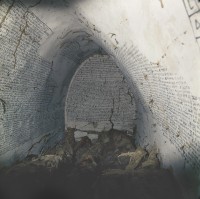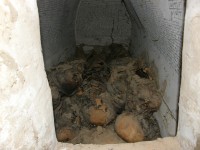The archaeological site of Old Dongola in what is today Sudan has a rich history. Originally built as a fortress in the fifth century, Dongola grew into a prosperous town thanks to its Nile-side location and, after its conversion to Christianity by the end of the sixth century, became the capital of the Coptic Christian kingdom of Makuria. In the seventh century, Makuria was able to defeat the forces of the Rashidun Caliphate after its successful invasion of Egypt. The ensuing peace treaty established trade relationships between Muslim Egypt and Christian Nubia that lasted for 600 years, a long period of stability that allowed the Kingdom of Makuria to flourish. The kingdom’s power began to wane in the 12th century and it was finally defeated by the Sultan of Egypt in the 14th century.
In 1993, the Polish Archaeological Mission (PAM) discovered three burial crypts in the northwest annex of a monastery in Old Dongola. Archaeologists believe they were part of a commemorative complex built either at the direction of or for the burial of Archbishop Georgios, Dongola’s primary cleric who was appointed directly by the Coptic Patriarch of Alexandria rather than via a national church hierarchy. According to a funerary stele found in the annex near the crypts, the archbishop died in 1113 A.D. when he was 82 years old.
 Inside each chamber were several natural mummies, some wrapped in textiles, and the walls of the southernmost crypt were covered with inscriptions written in Greek and Sahidic Coptic. The crypts were photographed and then resealed to preserve the contents until a more thorough excavation could be done. That finally happened in 2009.
Inside each chamber were several natural mummies, some wrapped in textiles, and the walls of the southernmost crypt were covered with inscriptions written in Greek and Sahidic Coptic. The crypts were photographed and then resealed to preserve the contents until a more thorough excavation could be done. That finally happened in 2009.
They found that the southern crypt (crypt 1) held seven mummies, one of which is thought to be the body of Archbishop Georgios. Archaeologists were not able to single out which of the bodies, if any, was the Archbishop’s. They are all adult males older than 40 and, judging from the extensive evidence of chronic and degenerative illnesses, probably older than that at the time of death. The bodies were dressed fairly modestly, mainly in linen garments, wrapped in shrouds and then interred in the crypt over a course of years. Four pectoral crosses were found in the crypt as well, two of them wood, one of them stone, one of them glass.
The inscriptions on the walls of crypt 1 provide a particularly fascinating glimpse into Makuria’s unique religious culture. Painted in black ink over a thin layer of whitewash, they cover the four walls of the barrel chamber almost entirely. They are in very good condition, except for areas where the walls themselves were damaged. The writing was all done by the same person, one Ioannes, who did us the favor of signing his name at the end of the inscriptions on the north, east and south walls. He probably signed the west wall too, but it was lost due to damage.
 Ioannes was better at Coptic than he was at Greek. There are copious errors in the Greek, some of which he covered with whitewash and redid, like Medieval white-out, which suggests he may have been trying to copy a text, which suggests he had access to a library, either in the monastery or perhaps the private library of the archbishop. It’s a reversal of what you might expect, since Greek was still going great guns in the Eastern Church while Sahidic Coptic was already a dying language by the end of the 11th century.
Ioannes was better at Coptic than he was at Greek. There are copious errors in the Greek, some of which he covered with whitewash and redid, like Medieval white-out, which suggests he may have been trying to copy a text, which suggests he had access to a library, either in the monastery or perhaps the private library of the archbishop. It’s a reversal of what you might expect, since Greek was still going great guns in the Eastern Church while Sahidic Coptic was already a dying language by the end of the 11th century.
The inscriptions begin on the west wall with an invocation of the Holy Trinity. Underneath that the writings are defined as a phylakterion malakias, a phylactery or amulet against weakness. A series of magical symbols in a frame follow, and beneath them are two lists, one of numerical cryptograms representing the names of god and angels, the other of magical divine names. Quotations from the gospels and prayers in Greek are next. One of the prayers, said to by the Virgin Mary, is well-known in a languages from Coptic to Arabic, but this is the first time it’s ever been found in Greek. Since Greek was probably its original language, it’s a highly significant find. The prayer ends abruptly with the invocation of a magical ritual meant to chase evil spirits from the tomb.
The inscription on the east wall quotes from the Gospel of Luke in Greek then moves on to a Coptic piece on the death of the Virgin Mary. It includes the prayer she spoke before she died and describes her final scene. This is an excerpt from a popular fourth century Coptic work by Saint Cyril of Jerusalem, but unlike every other extant version of the text known, the crypt inscription has a curious line: after Mary finishes praying, death appears to her “in the form of a rooster.”
From the paper on the inscriptions in the journal Polish Archaeology in the Mediterranean by University of Warsaw professor Adam Łajtar:
The decoration of the burial vault may therefore be properly described as a silent ritual, intended to safeguard not only the tomb, but primarily those who were buried inside of it during the dangerous liminal period between the moment of dying and their appearance before the throne of God. The entire ensemble of texts and architecture must be considered a unique and important witness to the funerary beliefs and practices of Christian northeastern Africa in medieval times.
Death ‘in form of a rooster’ ? – Well, before the rooster crows twice: There are maps that further illustrate the reported developments. Firstly, several kingdoms on the arabian peninsula adjoining the Roman and Persian Empires and the nubian christian domains of Makuria, Nobatia and Alodia next to christian ethiopian Axum and the Blemmyes in 565 AD and, secoundly, what is referred to as the ‘Age of Caliphs’ in the 7th century, maybe both maps in combination with the article on ‘Baqt’, i.e. the ‘treaty’ that was finally defeated by the Sultan of Egypt in the 14th century.
Intriguing idea linking “death in the form of a rooster” to the cock that crowed after Peter’s betrayal. Thank you for the maps too. :thanks:
I find Medieval history fascinating, and Christianity during this era even more so. The fact that this is also Coptic and Sudanese makes this off-the-charts interesting. I don’t know much about the Church in the East.
It is peculiar to me that there is a heavy dose of “magical” elements in the writing, given that it is surrounded by Christian texts. Do you know what exactly these magic rituals and imagery say/depict? I wonder whether these are not actually of Christian origin; perhaps something resembling what the RCC calls an exorcism. While I can’t imagine someone of Abrahamic faith thinking of a Catholic/Orthodox rite as “magical”, I could see how someone not familiar with such things might not make a distinction. If this is indeed of pagan origin however (e.g. ancient Greek, Roman, tribal, etc.), all I can say is that there is little continuity or coherence to the inscriptions. This is especially the case given that the writer’s name was John, and it was written in the 12th century. The only explanation that I can think of is that there must’ve been more pagan influence in NE Africa (perhaps visiting tribes?) than in the heart of Europe during this period.
Sorry for writing so much. On another note, I want to thank you for keeping up with all the historical news out there. I’ve been regularly following your blog for over 6 months, and it’s been a pleasure to read.
And one final question, since I’m already writing: who is Livius Drusus? I tried looking him up, but found at least three historical characters by that name.
There isn’t a full transcript of all the writings that I’ve been able to find, but from the details in the Łajtar paper there appears to be little specifically pre-Christian verbiage besides two SATOR squares on the north and south walls. It’s Christian scripture, canonical and apocryphal, that is put to magical use, in this case as apotropaic invocations. Ioannes made that intention explicit when he described the inscriptions as phylakterion malakias, and there is a rich tradition in the eastern church of using the first and last lines of the gospels to ward off evil.
Having said that, you are absolutely right that the traditional polytheistic Meroitic religion did survive in the area long well after its neighbors had fully converted to Christianity. They even contemplated an invasion of Egypt in the fifth century to stop Christians from converting ancient temples into churches. By the end of the 6th century, however, Byzantine missionaries had successfully converted Nubia to Christianity.
My Livius Drusus is the tribune M. Livius Drusus who attempted to extend the franchise to all of Italy and was assassinated for his trouble in 91 B.C.
Finarfin —
You’re talking about a religion whose deity was born of a virgin, performed miracles, died and was resurrected after 3 days, only to be swooped up to heaven some weeks later. Where is the non-magical part?
I agree this is a super-interesting find, especially for someone like me who is well versed in medieval western Europe but completely ignorant about medieval Africa. Thanks again & always, Livius!
Glad you dug it, Rebecca. 🙂
And thanks, Eve E., for the cool maps! I’m embarrassed to say I’d never even heard of Dongola.
The word magic has a specific connotation. The medicine-man performed magic. Pharaoh’s satraps perform magic. The Druids perform magic. Traditionally, even those who did not believe in Judaism or Christianity acknowledged that the claims, true or false, were claims of the miraculous, not the magical. The difference in wording is a distinction worth noting, as one speaks of Divine intervention without man’s merit, while the other is about man’s increase in power through appeasement of a deity eerily similar to us, or an amorphous, non-intelligent force.
This goes far beyond some theological debate. Not using the proper terminology can lead to confusion. With confusion, the anthropological significance is lessened. For instance, I now must ask: does the content of the inscriptions provide evidence that there was a working relationship (and mutual influences) with other cultures through trade or some other means, or is this just some careless mislabelling? Unfortunately, I cannot just assume that religious terminology is used correctly, and therefore I am still ignorant on this point.
Your distinction between the miraculous and the magical is well-stated. I’d pick a nit only insofar as “a deity eerily similar to us” could describe the Christian God (who did, after all, incarnate into human form and go through the human experience of birth,life, death) as much as it could describe, say, Zeus. Also, warding magic is tremendously promiscuous. Using certain words, symbols or gestures to block evil spirits/demons/bad luck/bad juju figures in every religion and culture I can think of.